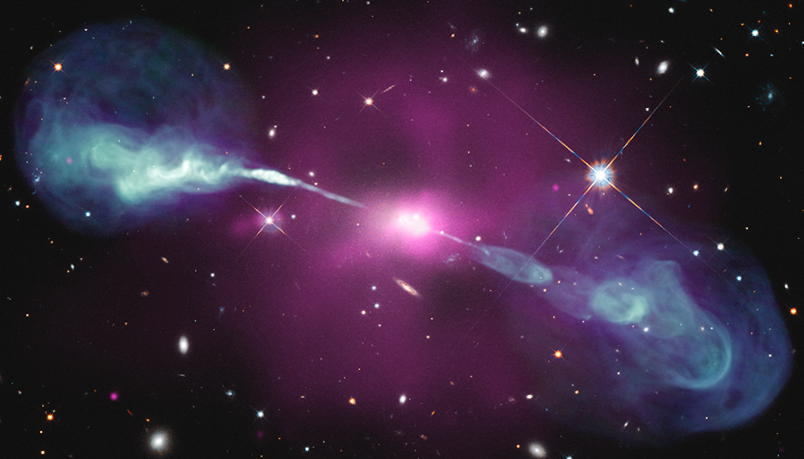
Observations
Astronomers observe the atmospheres of galaxies with telescopes that collect many different kinds of radiation, from X-rays to visible light to radio waves. This collection presents some of the most beautiful images of galactic atmospheres.
In the image above, two narrow jets are shooting out of the galaxy Hercules A into the surrounding atmosphere. X-ray photons from the hot gas are shown in purple and radio waves emitted by relativistic electrons in the jets are shown in blue.
-

Galactic Wind
Multiple supernova explosions in the galaxy M82 are driving a powerful wind that blows gas out of the galaxy, produces X-rays (blue) and infrared radiation (red), as well as visible light (green and orange).
-

Atmospheric Waves
Wavelike disturbances in the hot atmosphere around NGC 1275, the central galaxy of the Perseus Cluster of galaxies, include sound waves and ripples similar to water waves, along with bubbles inflated by a supermassive black hole.
-

Galactic Superbubble
In this composite image of the galaxy NGC 3079, with X-rays shown in purple and visible light shown in orange, a large bubble can be seen rising out of the galaxy toward the right side of the image.
-

All Sky X-ray Milky Way
The eROSITA survey has detected X-rays coming from all directions in space, giving us this all-sky view of hot gases in the Milky Way’s atmosphere.
-

Magnetic Fields in the Milky Way
This image from the Planck telescope shows how magnetic fields change their alignment within the Milky Way’s atmosphere.
-

Giant Bubbles in a Galaxy Cluster
In this composite image of the galaxy cluster MS 0735+7421, visible light from the cluster’s galaxies is shown in yellow, X-rays from the cluster’s hot atmosphere are shown in blue, and radio waves from high-speed electrons are shown in red.
-

Winds from Young Stars
Gases flowing out of young stars in this part of the Large Magellanic Cloud are sculpting the atmosphere around them.
Wispy Plasma Bubbles
In this radio-wave image of the galaxy Centaurus A, jets of plasma energized by a supermassive black hole are filling two large bubbles above and below the galaxy.
Glowing Hydrogen Gas Clouds
This composite image of the Hubble Ultra Deep Field shows starlight from galaxies in full color and glowing hydrogen gas clouds around some of the most distant galaxies in blue.
-

Radio Waves from the Milky Way
Near our galaxy’s center, bubbles and filaments threaded with magnetic fields confine fast-moving electrons and cause them to emit radio waves, as revealed in this image from the MeerKAT array of radio telescopes.

